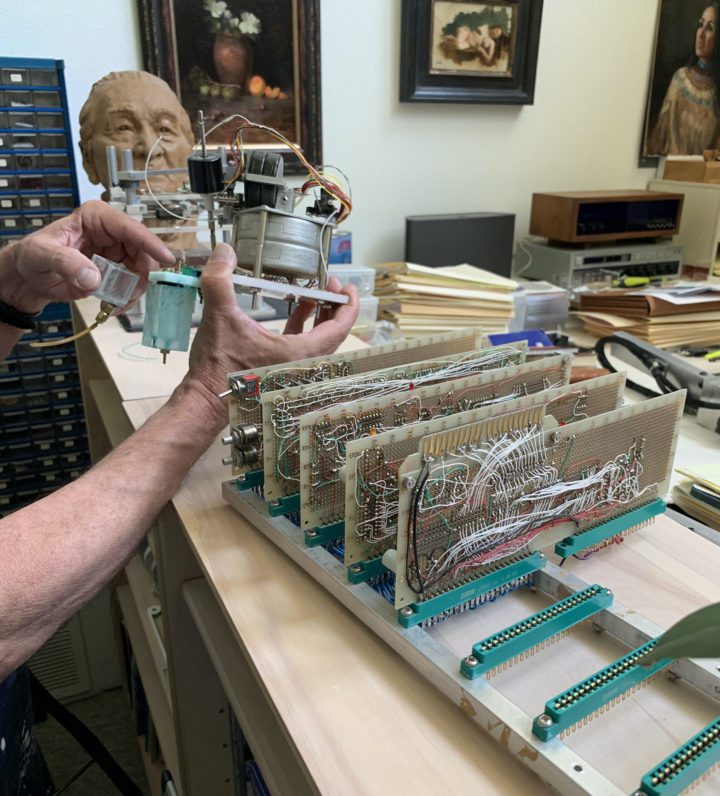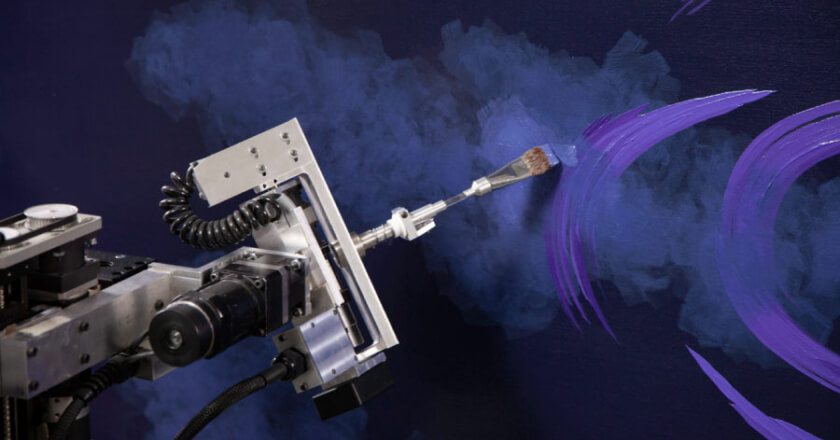Get Inspired
Build the life you love. Learn more about fusioneering:

Posted on December 21, 2021 in AI Painter
How does something like Dulcinea, Paul Kirby’s fully-automated robot artist, take shape? Just what kind of considerations and challenges arise from attempting to create a new, complex fusion of computing, mechanics, and two-dimensional art? We talked to Paul Kirby to learn more about the varied inspirations and processes behind building and refining Dulcinea.
It was 1994 when Paul Kirby began to realize his dream of fusing art and science in earnest. To be surrounded by an environment of art and artists, Paul moved to scenic Loveland, Colorado, a city renowned for its arts programs — including a public sculpture garden that hosts one of the best annual international sculpture festivals in the United States. Paul started leasing a studio at the Loveland Arts Centre, and began participating in the fine arts courses put on by the center. For seven years, Paul was able to study under a variety of talented, nationally recognized artists. One such artist was Glenn Vilppu, an internationally acclaimed fine artist, draftsman, painter, art instructor, and former layout artist for Walt Disney Studios (among other things). Glenn visited Paul’s studio after a class, and was amazed by the work being done. Such was the beginning of a long and fruitful friendship. Alongside Vilppu’s group of studying artists, Paul has now been to Europe nine times, observing and learning across all the major art capitals and museums of the European continent.
During this study of the classical masters, Paul came to fully realize and appreciate their individual contributions to the dynamic, indefinable, ever-changing field of artistic painting. Each painter strove to push the envelope of their craft for the craft’s own sake, in addition to striving to create a distinctive and lasting legacy for the powerful new styles and works they produced. It was this study, and Paul’s respect for the masters in the field of painting, that inspired and still informs all of Paul and Dulcinea’s work today. Like those masters, with each new painting Paul, too, is trying to explore and expand his own envelope of work, pushing the boundaries of what he and Dulcinea can technically and artistically achieve.
Not surprisingly, a robot to rival the Renaissance masters isn’t built overnight. Not only that, but the road to achievement is often winding and complicated — especially when complex mechanical systems are involved.
Read More: Follow Paul’s Journey To Build Dulcinea
Once Dulcinea’s steel frame was constructed and all the motors were installed on their moveable carriage systems, Paul then had to configure the robotic operating system for the details of each specific motor. Every motor required that several pages of custom calculations be installed in the operating system for proper configuration of the robotic joints. One at a time, each motor’s power was “brought up,” tested, evaluated for efficiency, and adjusted until optimal performance was achieved. The process included calibrating and installing the physical range of movement for each motor under development. For example, during a test run, Dulcinea would be happily moving across her x-axis of motion, when suddenly, somewhere in the middle, she’d crash. The diagnostic message on the computer screen would say “x-axis out of range.” Pulling out his hair, Paul would exclaim, “How could that be? She’s sitting right there in the middle of her range of motion!” As any computer engineer knows, a monumental number of small tweaks and changes were required to iron-out bugs and kinks in the system.
Additionally, large, sudden surges of electrical power were needed when dynamically driving the powerful, high-performance servo motors required to move Dulcinea’s heavy loads, — such as movement of the whole robot left-to-right. When power currents surge through lines, they create temporary electromagnetic fields known as “electrical noise.” When power cables are near data cables, the electromagnetic noise jumps across that space and corrupts the data lines, causing catastrophic results. The longer the cable, the stronger the electromagnetic field from surging current — turning Dulcinea’s fifty feet of cable into a giant transmitter of problems. The only solution was careful cable management.
These initial issues were all, on their own, small problems; however, they accumulated into a pile of technical challenges — challenges a modern observer of Dulcinea would never notice and might never consider. Only by defeating the innumerable, unromantic, gloryless issues found in mechanics and coding could Paul Kirby march towards an end product worth discussing.
But, even a working robot presents challenges.
For Dulcinea’s first two paintings, Paul was required to manually load each paint color and manually wash the paintbrush bristles between colors. Paul would wait around for Dulcinea’s electronic beep, the indication of the request to exchange and load the next color. A number on a screen would show the exact shade and color of paint required, and Paul would oblige with a swap before waiting for the next beep. In short, Paul Kirby was his robot’s babysitter. After those first few paintings, Paul knew something had to change; Dulcinea required a greater level of automation.
Paul then developed a few new abilities for Dulcinea, including paint loading and unloading sequences, brush washing and drying, and paint sealing (to protect the acrylic paints from drying out). A system of pneumatics was used for the paint handling arm, which included extension and gripping components for grasping and replacing different colors of paints.
A brush washing implement was added, including the ability to manage clean and dirty water. This was no easy feat, as water supply and drainage systems were located ~80 feet from Dulcinea’s control cabinet and another ~50 feet up and around and through the structure’s cable carriers to the wrist and brush washer). As a final cherry on top for this series of innovations in Dulcinea’s design, Paul added one last piece of code: Dulcinea would now, upon completing her last brushstroke, return her last paint to the shelf, seal it, fully clean her brush and return her body to her designated parking area. Paul could leave the robot, Paul could go home, Paul could sleep. And so, dreams of future paintings swirling through his head, Paul did just that. The next morning, Paul found that not only had Dulcinea autonomously produced the work set out for her and cleaned-up her own tools, but she had also taken the liberty of powering herself down. Dulcinea had achieved something truly magical: the surprise and delight of her own creator.
When is a work of art finished? According to research, for DaVinci, the famous Mona Lisa may have taken fourteen years — fourteen years of constant changes, refinements, and a mindset in the creator that the work would never be quite good enough. Even after all those years, DaVinci never felt the painting was finished. It’s a constant lament of the artist: a battle between finishing something and attempting to make it better.
It is because of Paul Kirby that Dulcinea finishes her art in a timely, efficient manner — but Paul’s art is Dulcinea herself, and Dulcinea is a work of art that will be forever changing and evolving — taking on grand new abilities, shades of meaning, and cultural complexity. Whatever the challenges may be.
Want to stay up-to-date with every change to Dulcinea? Join our mailing list to track every exciting development at the Kirby Foundation!
Are you interested in hearing the complete story of Paul and Dulcinea? Watch the video (nominated for Best Short Film at the 2021 Vail and Portland Film Festivals) for more info.
Want to be the first to know about every exciting new project at the Kirby Foundation?
Join Our Mailing ListBuild the life you love. Learn more about fusioneering:
Why pick which passion you should follow? Fusioneering allows you to cultivate many interests into something innovative and revolutionary.

Meet Paul and explore how blending your interests can empower you to follow your enthusiasm and bring your passions to life.